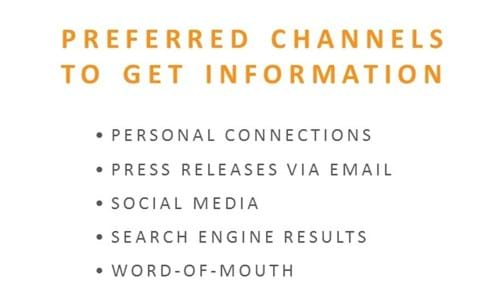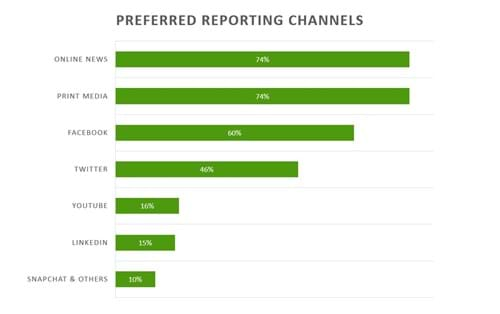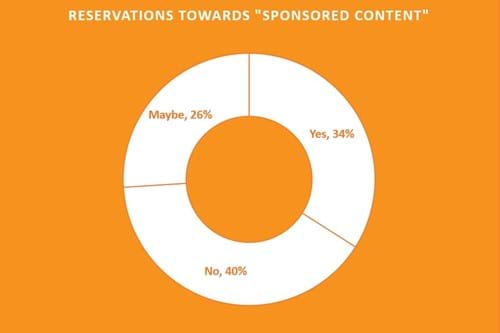
What Do Journalists Really Want?
What goes on in the heads of journalists? In the Journalism Trends 2016 report by PR and marketing platform Mynewsdesk, more than 2,000 journalists from around the world were surveyed, including those from the US, UK, Nordic countries, Singapore, Australia and more.
Report findings


#Funfact:
Journalists publish their stories across an average of 3 channels.
Press releases, the lifeblood of PR
Often used as a tool to help articulate facts for journalists as background info, the press release is considered by many journalists to be a secondary source of information (sort of like Wikipedia, just more credible). In fact, more journalists are turning to Facebook and Twitter, quoting excerpts by spokespersons instead of pulling official quotes from press release. Gradually evolving, no longer are press releases restricted to the traditional text-based structure. We need to start exploring using different formats, such as blogs, video releases, photo stories and more to entice the media.
Journalists’ main pain points:
- Lack of time
- Lack of relevance in stories
- Communicators should always be clear of their target audience in order to pitch the right angles to the right media
- Lack of visual assets (images and videos etc.)
Quick tip:
Starting your pitch note with “Hope this email finds you well…” is just boring and has been done to death
Content marketing
When it comes to content marketing, some journalists find it acceptable, but has to be done right, i.e. full transparency by specifying what’s been paid for. Content marketing should also have independent credibility, and not be laced with branding/product messaging (because sometimes, less is more). Otherwise, it might as well have been an ad! We need to understand that the purpose of content marketing is not to place our clients’ products/branding too blatantly where it becomes a hard-sell, but to tell the story in a way where it can build reputation.

Bright side, there is still a spectrum of independence among the audience in earned, paid and owned media, and they roughly know what to expect from each channel. For example, when people read branded blogs, they know that they are unlikely to find an unbiased POV comparing the brand with its competitors. Instead, they are reading because they are drawn to the storytelling.
Top journalist pet peeves
Cluttered mailboxes
- Meaningful email subjects and headers definitely fly well with journalists (strictly no clickbaits TYVM), and can quickly give them an idea of what the story is about. It’s also wise to not bury essential information within the email body or attachments
Lack of visuals
- Always provide as much visuals as possible, especially for social media since Facebook algorithms tend to prioritise content with visuals.
Being hounded to RSVP
- Journalists are often handed assignments at the last minute, so it’s better to follow up closer to the date of the event and not badger them for a response. Note that “closer to event” refers to one or two days before, not a week before, and definitely not more than that. Due to the difference in lead times that journalists and communicators are working with, what may seem like last-minute to us, may be considered ample time in “journalist years”.
The times, they are a-changing…
Journalists have adapted to the digital era, resulting in significant changes to their job scope and their approach to stories and pitches. Platform journalism also means that content on social media might not necessarily sit on the website.
So why social media?
- Faster audience reach (puts the “insta” in Instagram)
- Higher share-ability factor
- Can feature live events – FB Live/Snapchat
- Newer features, e.g. 360-degree videos which are best viewed on mobile
Quick tip:
Going viral: Audience Versus Numbers
- Don’t get too fixated on “going viral”, always remember that quality trumps quantity. Simply put, it’s a matter of reaching the right audience, as opposed to a large audience who are not interested in your message. Also, viral stories tend to have a shorter lifespan. Case in point: Is anyone still talking about The Dress? #blackandbleugh
What should we then, as communicators, take note of when pitching to digital players?
Keeping the audience experience in mind, story angles should enable journalists to deliver an experience to their audience, instead of it being just another piece of content. Try thinking from a journalist’s point-of-view when pitching your story, and looking at it from a digital and social media angle.
Journalists also welcome events with photo/video opportunities with open arms, even more so if social media sharing has been taken into consideration. Provide them with plenty of visuals/graphics, but take note not to clog their inboxes with large files. Ever heard of Dropbox?
Another approach we can take would be to consider telling the story only on social media. A story sitting purely on social is open for a lot more adventurous formats which can attract more engagement from the audience, as opposed to them sharing a regular link post to the article on their Facebook page.
As Karen Lim, the acting editor of Asiaone, so aptly puts it:
“There are no best practices in digital.”
Seeing as how digital media and practices are constantly evolving, there is no fixed formula or overriding digital strategy that can ensure optimum engagement. The only way to stay on top of the game is to keep experimenting, and keep trying out new ways to tell your story. Definitely a nice sentiment to share with clients, don’t you think?
Mervyn Lee supports the WE Singapore team on digital/social content creation, development and strategic implementation. He works on multi-market and integrated cross-functional teams to support global brands across various healthcare and consumer accounts.
The latest blogs from WE
Decoding Gen Alpha: A Primer on the Next Gen of Consumers
Why Gen Alpha Will Fuel Spending This Season
Why Reputation Is a Business Driver in Healthcare

